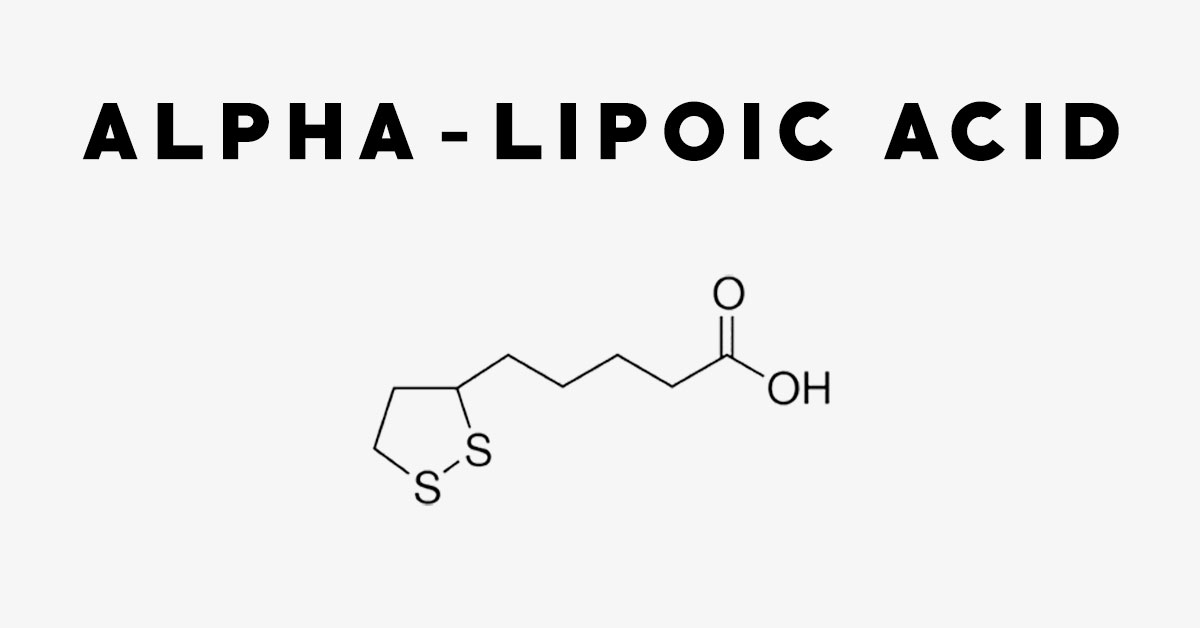
28 Aug What is Alpha-Lipoic Acid (ALA)? Dosage & Side Effects
Lipoic acid is a natural antioxidant and anti-inflammatory fatty acid with a suite of essential features, from vitamin metabolism to mitochondrial respiration. Keep reading to find out more about how this chemical works and how to incorporate more of it into your daily diet.
What is Lipoic Acid?
Amino acid (LA), also known as ellagic acid (ALA), R-lipoic acid, or thioctic acid, is a disulfide-containing compound, located inside each cell of the body.

Some call it the “universal antioxidant”.
List of Important Functions for Lipoic Acid:
- Lipoic acid acts as a strong antioxidant both inside and out of the cells.
- Lipoic acid scavenges many reactive oxygen species (ROS).
- Lipoic acid can help regenerate both fat and fat-soluble antioxidant vitamins (for example, vitamins C and E).
- Lipoic acid enhances fat and sugar metabolism.
- The amino acid is an essential cofactor for mitochondrial respiratory enzymes which enhances mitochondrial function. Lipoic acid exerts a”rejuvenating” effect on mitochondria by protecting them against the high rates of
- ROS they create through the aging process.
- Lipoic acid also has anti-inflammatory activity, independently of its antioxidant activity.
Production of Lipoic Acid from the Body
A healthy body makes enough ellagic acid to provide its energy demands; therefore, there is no daily requirement for this particular supplement. However, many medical conditions appear to be accompanied by low levels of lipoic acid — specifically, diabetes, liver cirrhosis, and cardiovascular disease.
In areas of Europe, lipoic acid is approved for the treatment of diabetic neuropathy. It’s been demonstrated to enhance insulin sensitivity, improve microcirculation in the limbs, and reduce neuropathic symptoms.
Additionally, lipoic acid produced in the body decreases with age, which might increase free radical-induced harm. Lipoic acid supplementation in animal models has also extended lifespan and prevented neurological harm.

Antioxidant Activity
Lactic acid neutralizes free radicals and associated oxidative cell damage.
Lipoic acid scavenges several reactive oxygen species (ROS).
Lipoic acid also helps regenerate antioxidant vitamins C and E.
Additionally, lipoic acid boosts the activity of other antioxidants such as glutathione and coenzyme Q10, which are two fundamental anti-aging health-promoting compounds.
Lipoic acid increases tissue GSH levels, which decline with age, by restoring glutathione peroxidase action.
Ongoing Speculative Research
Cancer Research
These early studies suggest that lipoic acid is acceptable for further study in cancer research. They are not reasons to urge ALA supplements to cancer patients. Many compounds seem to have”anti-cancer effects” in cell studies, but neglect to do anything against cancer in animals or humans.
Cell-based and animal model studies have suggested that lipoic acid can inhibit the initiation and promotion stages of cancer.
ALA has also been examined for its possible impacts on lung and breast cancer cells.
Topics of Future Research
Because of its antioxidant and anti-inflammatory consequences, lipoic acid is presently being researched in the context of a number of health conditions.
Be aware that a number of these conditions just have one study accessible, which means that the proof is nowhere close to the vicinity of adequate to urge ALA for patients.
A few of the requirements are listed below.
- Hypothyroidism: In patients with subclinical hypothyroidism, lipoic acid-enhanced endothelial function, by decreasing oxygen-derived free radicals.
- HIV disease: In human immunodeficiency virus (HIV)-infected subjects with a history of unresponsiveness to highly active antiretroviral therapy, lipoic acid improved glutathione levels and enhanced or stabilized lymphocyte proliferation.
- Cystinuria: Lipoic acid inhibited cystine stone formation in mice.
- Liver Surgery: Lipoic acid reduced ischemia/reperfusion harm of the liver in humans undergoing the liver operation.
- Heart Surgery: In patients with coronary heart disease and those planned for coronary artery bypass graft operation, lipoic acid significantly diminished inflammation when blood flow is eliminated from the body (extracorporeal flow).
- High-fructose corn syrup caused pancreatic damage: Lipoic acid ameliorated metabolic modifications and pancreatic lesions.
- Peripheral Artery Disease: 3 months of lipoic acid supplementation improved walking tolerance and delayed pain onset in peripheral arterial disease.
- Acute Coronary Syndrome: Lipoic acid ameliorated oxidative stress in patients with confirmed acute coronary syndrome (ACS).
- Takotsubo syndrome: Takotsubo syndrome is a sort of stress-induced heart muscle damage. Lipoic acid improved the innervation of adrenergic nerve cells in the hearts of patients with Takotsubo syndrome.
- Heart Failure: Lipoic acid prevented heart cell death, averted advanced heart remodeling, and improved heart function in animal research.
- Olfactory Loss: Infections of the upper respiratory tract occasionally result in the reduction of the sense of smell. Lipoic acid enhances olfactory function.
- Idiopathic dysgeusia: In patients with idiopathic dysgeusia, a modified perception of flavor, lipoic acid was correlated with significant symptomatic improvements.
- Sickle Cell Disease: In patients with sickle cell disorder, lipoic acid shielded a subset of patients from oxidative damage to proteins and fat.
- Polycystic ovary syndrome: A combination of lipoic acid and d-chiro-inositol (DCI) enhanced clinical and metabolic health in women with polycystic ovary syndrome. Supplementation of myoinositol and lipoic acid-enhanced reproductive outcome and metabolic profiles in PCOS women undergoing in vitro fertilization.
- Chronic Spinal Cord Injury: In men with chronic spinal cord injury, lipoic acid decreased fasting blood glucose, body weight, BMI, waist circumference and blood pressure. Lipoic acid also decreased food intake.
Lipoic Acid Mechanisms
Antioxidants and antioxidant enzymes:
- Increased glutathione (GSH).
- Increases superoxide dismutase (SOD).
- Increases catalase (CAT).
- Increases Nrf-2.
Markers of oxidative stress:
- Decreases malondialdehyde (MDA).
- Decreases myeloperoxidase (MPO).
- Decreases troponin-I amounts.
- Decreases Nox4 and p22phox (CYBA).
Inflammation:
- Reduces both Th1 and Th2 cytokines.
- Decreases TNF-α.
- Decreases IL-2, IL-4, IL-1β and IL-17.
- Can raise, but largely reduces IL-6.
- Increases IL-10.
- Decreases CRP.
- Decreases NO, but could also increase NO.
- Decreases iNOS.
- Suppresses NK mobile activation.
- Decreases TGF-beta.
- Decreases IFNγ.
- Decreases NF-κB.
- Decreases MMP-2 and MMP-9.
- Decreases ICAM-1 and VCAM-1.
- Decreases MCP-1 (CCL2) and RANTES (CCL5).
- Increases heme oxygenase (HO-1, HMOX1).
Fat metabolism:
- Activates AMPK.
- Modestly reduced nonesterified fatty acids (NEFA).
- Increases the LDL receptor (LDL-R).
- Decreases PPARγ, C/EBPα, and C/EBPβ.
- Increases SIRT1.
- Increases PDK4.
- Increases PPARβ (PPARD).
Cardiovascular system:
- Decreases endothelin I.
- Decreases AT1.
- Decreases PAI-1.
Brain function:
- Increases acetylcholine (ACh) and choline acetyltransferase (ChAT) and reduces acetylcholinesterase (AChE) from the hippocampus.
- Increases VGlut1.
Cells and mitochondria:
- Increases Bcl-2.
- Decreases Bax, caspase-3 and caspase-9 activity.
- Increases PGC-1α (PPARGC1A), TERT.
Sources of Lipoic Acid
Dietary
- Vegetables (broccoli, spinach, tomato).
- Meat (kidney, liver, heart).
Supplemental Doses
Available nutritional supplements come in doses of lipoic acid involving 600 — 1,800 mg daily [9]. Studies demonstrate that increased dosage is also followed by increased side effects.
Cosmetic Dentistry acid has a limited bioavailability of approximately 30% [48]. Studies show that there’s significant inter-subject variability in peak blood lipoic acid concentrations, as a result of individual differences in gut absorption.
Possible Risks and Side Effects
Urticaria and itching are the most common adverse events, but they are usually mild and go out on their own.
Lipoic acid can also be connected with a dose-dependent increase in nausea, vomiting, and vertigo. Greater doses of 1,200 mg and 1,800 mg have more frequent adverse effects. An oral dose of 600 mg once daily appears to offer the optimum risk-to-benefit ratio.
This is especially the case in the older people, in which 600 mg dose was well taken, but high doses caused intolerable flushing and excruciating upper gastrointestinal side effects. But issues taking gastrointestinal prophylaxis medications had no upper gastrointestinal side effects.
Lipoic acid (potential overdose) may cause refractory convulsions in children.
1 study in mice suggests that prophylactic and abundant consumption of lipoic acid induces fatty liver and liver injury. There is one recorded instance of lipoic acid causing severe cholestatic hepatitis in people. It might be prudent to monitor cholesterol and liver enzymes using long-term lipoic acid supplementation.
Finally, in rats, it was shown that lipoic acid reduces the absorption of iron. Lipoic acid supplementation could potentially cause iron deficiency anemia. No such events have been reported in people however.
Talk with your physician before supplementing with ALA to prevent adverse events and unanticipated interactions.
The most frequent side effects of lipoic acid supplementation are itching, though some people also experience nausea, vomiting, and vertigo.
Takeaway
Alpha-lipoic acid (ALA) is an antioxidant fatty acid with many essential functions in the human body. Especially, it helps regulate antioxidant vitamins (such as vitamins C and E) and assists in mitochondrial respiration.
Lipoic acid is also the topic of a great deal of early insecure research. Some researchers believe it might play a part in suppressing cancer at the early stages, for example, but that has only been shown in cell studies. Limited clinical research also suggests that lipoic acid supplementation may prove useful as a complementary approach to traditional treatments for any number of conditions. As always, speak to your physician if you think supplements could help you achieve your health objectives.
The most frequent adverse side effects of lipoic acid supplements contain itching, nausea, vomiting, and vertigo.

Sorry, the comment form is closed at this time.